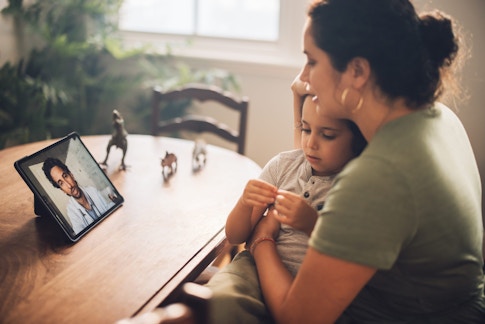
jacoblund/iStock
One of the gold-standard tools used to assess autism spectrum disorder (ASD) is the Autism Diagnostic Observation Schedule, Second Edition (ADOS-2), which is designed to be administered in person by a clinician (Lebersfeld et al., J. Autism Dev. Disord., 2021). During the COVID-19 pandemic, however, the use of face masks and barrier shields changed the social aspects of the testing environment, making standard face-to-face administration of the ADOS-2 no longer possible. Many clinicians and researchers were left searching for a feasible and effective alternative to the ADOS-2 that would not require in-person administration by a clinician. Although assessment of ASD through remote telehealth or technology-based approaches was already sparking some interest prior to the pandemic (Dahiya et al., Pract. Innov., 2020; Duda et al., J. Autism Dev. Disord., 2016; Tariq et al., PLoS Med., 2018), research on these measures was in the early stages. SFARI Investigators So Hyun Kim and Catherine Lord saw an unprecedented opportunity to innovate a much needed solution to the pandemic-related disruption of in-person assessments of ASD. Funded by a SFARI Director Award, Kim, Lord and their colleagues developed a new ASD assessment tool, called the Brief Observation of Symptoms of Autism (BOSA), that can be administered remotely through telehealth by someone (for example, a caregiver or therapist) without expertise in ASD (Dow et al., J. Autism Dev. Disord., 2021).
The BOSA was designed with some of the best features of the ADOS-2 in mind, such as providing a naturalistic context to observe social communicative behaviors. During use of the BOSA, a clinician observes a live or video-recorded interaction between an individual and their caregiver or therapist for a brief period (12–14 minutes), using standardized materials and activities that can be shipped or dropped off to families’ homes. Depending on the individual’s age and language level, one of four different versions of the BOSA is used, making it a good assessment option across different ages. After the observation, the clinician places their observations within a framework of standardized ADOS-2 codes. Ultimately, this process allows for flexibility in how families access BOSA materials, where they complete the BOSA and when the clinicians observe and code the BOSA — a level of flexibility ideal not only for social distancing requirements during the pandemic, but also for increasing healthcare accessibility for families in rural or less-resourced areas that may not otherwise have access to high-quality ASD assessments.
Before a new assessment tool can become mainstream and widely used by clinicians and researchers, it has to be extensively evaluated to verify whether it has certain properties — for example, whether it is valid, reliable and good at measuring what it is intending to measure — also known as psychometric properties. In their study, Kim, Lord and colleagues took a first look at the psychometric properties of the BOSA, including its sensitivity, specificity and reliability. Their preliminary data suggest that the BOSA is good at correctly identifying individuals who have ASD (sensitivity) and those who do not have ASD (specificity). As far as being reliable, the BOSA had good interrater reliability (the level of agreement between different raters) and test-retest reliability (the consistency of the results when the assessment is repeated later with the same individual). There was also good convergent validity between the ADOS-2 and some BOSA versions, essentially showing that a new tool designed to measure a particular construct (in this case, ASD traits) does in fact correlate with another previously studied, standardized tool that measures the same construct.
These initial findings set the stage for more in-depth examination of the BOSA with larger groups of individuals with ASD. Kim, Lord and their colleagues emphasized that the BOSA is meant to support the process of promptly diagnosing an individual with potential ASD when face-to-face assessments are not possible or safe, not as a standalone assessment that can be relied on to conclusively make a diagnosis. For an assessment to be comprehensive, other information, for example, developmental history, parent interview and other standardized diagnostic observations, would still need to be collected to make an accurate diagnosis. While this work is preliminary, it offers a promising new option for flexible, remote approaches to ASD assessment — now and in the future — as both families and clinicians have moved to embrace telehealth approaches.
Reference(s)
The brief observation of symptoms of autism (BOSA): Development of a new adapted assessment measure for remote telehealth administration through COVID-19 and beyond.
Dow D., Holbrook A., Toolan C., McDonald N., Sterrett K., Rosen N., Kim S. H., Lord C.


